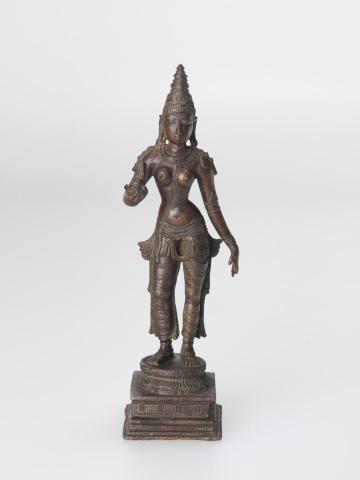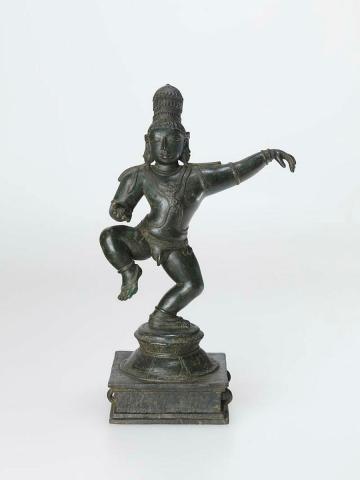UNKNOWN; Krishna the jubilant butter thief and Shivakami Uma
By Tarun Nagesh
The Chola kingdom (c.880-1279 CE) reached its height in the eleventh century, when it controlled much of south and east of the Indian subcontinent and formed one of the most important artistic riods in Indian history. Arts patronage abounded, with numerous temples, many of which still function today, constructed across southern India in veneration of the Hindu gods. The makers of bronze statuary reached an unprecedented level of skill and their works a level of significance, as images of the gods were made to be housed in the temples but also portable for processions and festivals in surrounding communities, and were believed to be actual embodiments of the deities.
Among the hundreds of gods that appear across India, Krishna is one of the most celebrated. He is not only revered as a supreme ruler and the eighth avatar of Vishnu, the preserver of the cosmos, but worshipped at a personal level in the form of bhakti, a humble sharing of love and devotion.(1) Krishna appears in many forms: as king, lover, flute player, dancer. He is often depicted playing the flute among the cows and cowherds, surrounded by enamoured gopis (female cowherd), or poised on one foot while subduing the fierce river serpent Kaliya by dancing on his head.(2) In the sculpture of southern India, Krishna is frequently represented as bala Krishna, a child. In this form, he was raised in the cottage of a cowherd to escape his uncle, King Kansa, who had imprisoned his parents and killed his brothers.
A Collection sculpture depicts Krishna as a mischievous youth in a cheerful dancing pose, holding a small ball of butter in his hand. He had stolen the butter from his foster mother, Yashoda, who demanded that Krishna open his mouth. Peering in, she could see the entire universe - a revelation of the child’s divinity. Krishna the jubilant butter thief shows Krishna posed in a relaxed and balanced position emulating Indian folk rather than classical dance. His body has the rounded softness of a child’s, and is decorated with fine necklaces, anklets and belts, tassels on his shoulders, heavy jewelled earrings, and a detailed chignon emphasising his height. This figure was later appropriated to depict the child saint Sambander, portrayed almost identically but with the protruding right hand pointing towards Uma, who had given him milk as a hungry toddler.(3) The figure expresses both the happy mischievousness of the act as well as the grace and divinity of the incarnation.
Another bronze sculpture in the Collection, Shivakami Uma, depicts Uma, the consort and shakti (female energy) of Shiva. Uma plays an important role in Hindu mythology - Shiva embodies the great force of creator and destroyer, but it is the female energy of Uma (also referred to as Parvati) who enables Shiva to activate his power to create.(4) The daughter of King Himalaya, Uma was born out of compassion for the gods, and for the purpose of bearing Shiva’s child who would be able to defeat the demon Taraka. However, the gods were unable to unite the pair - only after 36 000 years of performing ascetic feats in the mountains could Uma prove that her power and determination equalled Shiva’s and that she was acceptable as his bride.(5) Commonly appearing in temples alongside Shiva, Uma is the subject of devotional offering and is characterised by the presence of a lotus flower in her right hand. Standing on a double lotus base, here Uma wears an elaborate jewelled headdress, strings of jewels and pearls, bracelets, anklets and armlets, along with belts and sashes studded with precious stones, while her lined lower garment follows the gentle bend in her knees and hips.
These two figures are fine examples of works by the great Chola artists, and reveal particular nuances of Hindu customs and mythology. They tell the tale of a theft that revealed a child’s divinity, and of a supreme cosmic force that resulted in a gentle, welcoming beauty.
Tarun Nagesh, Artlines 3-2012, pp.44-5.
Endnotes
1 Heinrich Zimmer, Myths and Symbols in Indian Art and Civilization, Harper and Row, New York, 1962, p.27.
2 Heinrich Zimmer, The Art of Indian Asia, Princeton University Press, New Jersey, 1960, p.357.
3 Jim Masselos, ‘Worship and devotion’, in Dancing to the Flute: Music and Dance in Indian Art, Art Gallery of New South Wales, Sydney, 1997, pp.156-8.
4. Aschwin Lippe, ‘Divine images in stone and bronze: South India, Chola dynasty (c.850-1280)’, in Metropolitan Museum Journal, vol.4, Metropolitan Museum of Art, New York, 1971, p.69.
5. Zimmer, 1960, pp.118-20.

